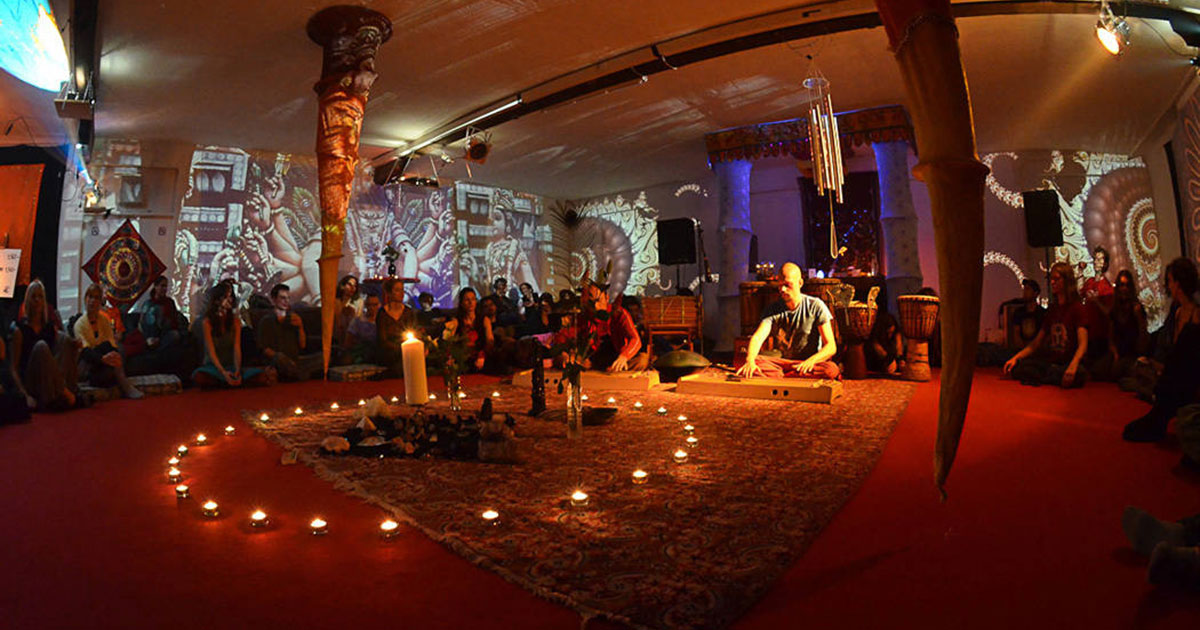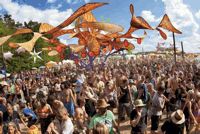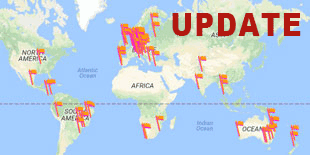This was the seed for the summer seasons from 1995 until 1998 with remarkable parties at Vegetal on the nudist beach of Trancoso, organized by Mikele and Alba, some of the parents of Trance in Brazil, together with friends from Trancoso and Arraial.
Paulo Lopes from Portugal, known as ‘Paulo the Blind’, became a resident DJ. DJ Celso from Minas, the first Brazilian DJ, also played here, followed by Andre Meyer, Mil (Daime Tribe/klatu), Swarup and Ekanta, who were the first non-foreigners to make the connection between Goa and Brazil and brought over new music from Goa. Joti Sidhu, Dino Psaras, Orion, and Shiva Space were also involved.
The Brazilian scene started to explode in 1999. Brazilian audiences from the main cities outnumbered the foreigners and parties jumped above the 500 people mark. In July, the producers XXXperience and Kranti created Spadelic, a ten day festival in Alto Paraíso, in the centre of the country, and which is considered to be the first national Trance gathering, linking and connecting the two national Trance spots, Trancoso and São Paulo.
The major breakthrough was in the year 2000 on New Year’s Eve with 3,000 people. All the first Brazilian tribes participated and Brazilian DJs had finally arrived on the world stage. Trancoso, with its new projects and ideas, was the place that acted as a stimulus for the national Trance scene.
In March 2000, Celebra Brazil (Etnicanet and Klatu) was the first international Trance festival in Brazil and was held on the São Paulo coast, followed in June of that year by the Trancendence festival in Alto Paraíso de Goiás. The first party producers in Minas (Psicotrance), Rio (Trancefusion) and Florianópolis appeared on the scene shortly after that. Alternative festivals were also organised in Goiás (Transformation and Kranti`s) and Minas Gerais also became a festival spot, first with Earthdance (Raveon/Psicotrance) followed by Cachoeira Alta (DJ Gui) and Sansara (DJ Miague) – all of them continuing until today.
From 2001, the scene spread even more. Trance Reveiilons took place in São Paulo and Rio, and Universo Paralello started off in Alto Paraíso, and grew to become the biggest Brazilian festival continuing until the present day.
Trancoso broke all records with twelve 3-day-festivals between 2001 and 2003. So, the main international DJs and producers such as GMS, Dimitri Nakov, Antaro, Serge, Edoardo, Shanti, Lotus Omega and producers from Boom, Voov, Sonica, Samothraki, Vision Quest, Raja Ram and Chicago came to Brazil. Many of them started their DJ career here, such as Wrecked Machines. Trancoso became a kind of Mecca of world Trance just like Goa, the difference being the hot and sexy Brazilian dancers. But as in other regions of Brazil, conflicts arose with the police due to economic interests.
When Universo Paralello moved to the north of Bahia in 2004, the Trancoso parties changed a lot. It is still the Brazilian Trance capital during the summer with parties but also serves as a chill-out place for many international and national DJs and producers. Its wild palm-fringed beaches still provide that cosy magic vibe and being the birthplace of Brazilian Trance, Trancoso is a historical part of Brazilian Trance culture that will remain for ever.
Apart from Trancoso, São Paulo developed its own Trance scene. The three first parties organized in 1994 to 1996 were done by the three initial local producers, Daime Tribe/Klatu (André, Mil, Nena,Tomas), XXXperience (DJs Rica Amaral and Feio) and Avonts (Dimitri). Together with Space, Digitalis, Psycogarden they made remarkable parties in the late 90s when Freakadelic and Orion and Respect showed up.
At the turn of the millenium, São Paulo, sharing second place in the ranking of the biggest cities in the world, became the major worldwide urban hub for Trance with indoor parties going on 7-days a week at different clubs, of which the only one remaining after ten years is Klatu. A number of different organisers held open air festivals every weekend. São Paulo even had a 3-floor Trance Gallery initiated by Glow Magazine with Trance culture shops.
Besides making his own private festivals, Klatu co-produced the two first international Festivals in the state of São Paulo: Celebra Brasil (with Max Lanfranconi from Etnicanet) in March 2000 and YpyPoty (with the Boom people) in January 2002. Both festivals were on the beach.
XXXperience grew rapidly to thousands of visitors and in 1998 the festival started expanding towards other major cities, such as Curitiba (Psycostreet), Brasília, and Goiânia (Transformation). This process helped the spread of Trance all over Brazil.
Around 2005, ten years after the Trance revolution began, XXXperience parties managed to attract between 10 and 20 thousand people, and became the biggest parties in Brazil. Competing with it, the recently emerged organiser Tribe achieved the same number of people in 2006 and subsequently started a national tour with huge full-on parties. They produced two Festivals – Solaris 2003 and 2005. Nowadays XXXperience and Tribe are the biggest commercial one-day open-air organisers.
Goiás, the state surrounding the capital Brasilia, in the Brazilian central highlands with astonishing savannah, natural parks, waterfalls and quartz crystals, was the third pillar of success in Brazil’s Trance scene.
The city of Alto Paraíso (High Paradise) is considered to be the national capital of ecology and new age mysticism and is home of the rainbow gatherings since the early 80s. In July 2000, one year after the precursor Spadelic, the Trancendence Festival started and grew to 7,000 people by 2005.
It was organised by the three brother-sannyasins Sargan, Vistar and Atheda from Solar Flares. Together with two smaller alternative Kranti festivals, Alto Paraíso became the Trance spot of the tropical winter season in the mountains thus complementing the summer trance spot on Trancoso beach. Some DJs moved there, many international DJs and producers passed by. Trance bars and shops appeared in town, and many private parties took place.
2001 was the beginning of the Universo Paralello New Year’s Eve festivals, also organised by the two sannyasin-brothers, Alok and Swarup. In 2004, Universo Paralello moved to Bahia’s Pratigi Beach, a wonderful coconut grove by the sea. With continuous and explosive growth, it celebrates its 10th edition 2011 and is attracting more than 15,000 people.
It is now an international event and serves as an escape for Europeans and people from all over the world allowing them to leave behind the northern winter and enjoy the tropical Brazilian summer. Universo Paralello is the best location for a Trance traveller to experience in Brazil these days.
Brazil provides the ideal conditions for the best open-air sceneries because of its year-round tropical weather, gorgeous natural locations and its huge young population. There is a strong and vibrant energy all over this huge country! It’s worth checking out!
Kranti Pessoa










